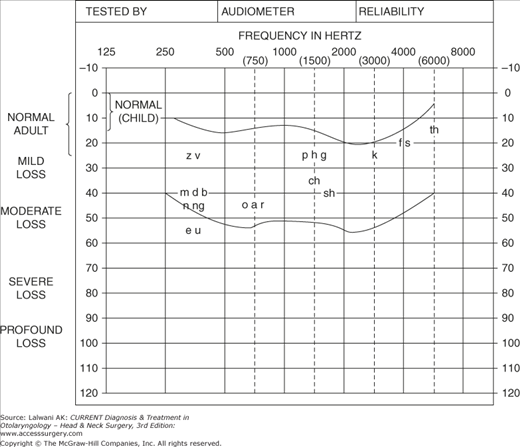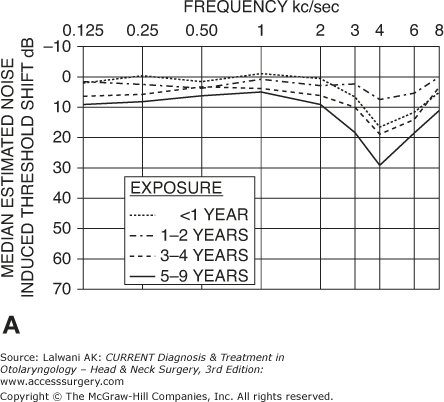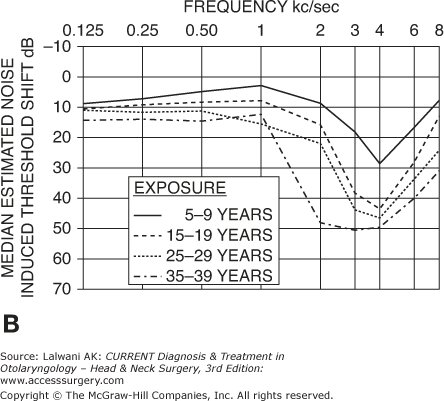Occupational Hearing Loss: Introduction
The hearing mechanism, being very sensitive to sound stimuli, is also very susceptible to injury. Many workplaces are hazardous to hearing health due to exposure to (1) noise, (2) physical trauma, and/or (3) toxic materials. Each of these elements comprises a separate subchapter in this review. The majority of the review is focused on noise damage as it is far and away the most prevalent type of occupational auditory injury. The final section discusses some medicolegal aspects of occupational hearing loss.
Hearing Loss Due to Noise
Occupational hearing loss is noise-induced hearing loss (NIHL) due to chronic overexposure to hazardous levels of noise in the workplace. NIHL may also occur from nonworkplace (eg, recreational) noise overexposure. Because the pattern of hearing loss is essentially the same, allocating occupational versus recreational noise damage remains a challenge. NIHL represents about 15% of the total societal burden of hearing loss among American adults. People with occupational NIHL represent approximately half that total, or about 2.5 million adults; another 2 million suffer NIHLs from nonoccupational or leisure activities such as hunting and target shooting, listening to loud music, or engaging in noisy hobbies or recreational activities.
In spite of considerable attention aimed at limiting noise overexposure–through wearing of personal hearing protection, engineered reductions in noise levels, and industrial hygiene measures–loss of hearing still occurs. The additive effect of aging upon the auditory system complicates the evaluative process even if serial examinations are available. Traumatic hearing loss in the military–both NIHL and acoustic trauma–is an increasing source of disability and compensation in the Veteran’s administration.
The goal of this review is to provide guidance for physicians who evaluate and treat people with suspected NIHL. We will focus primarily on diagnosis and evaluation, with updated information on prevention and remediation.
Noise may be defined as unwanted, undesirable, or excessively loud sounds as experienced by an individual. The effects of chronic noise exposure vary with the characteristics of the sound: damage is related to intensity, exposure duration, and exposure pattern (continuous exposures are more damaging than interrupted exposures for the same overall duration and intensity). Daily exposure to hazardous noise over years produces the characteristic loss of high-frequency sensitivity in the 4–6 kHz range (Noise notch–See Figure 58–1).
A less common but potentially more devastating form of occupational hearing loss results from acoustic trauma, wherein high-intensity impulse noises (eg, explosions) physically disrupt any or all parts of the ear resulting in immediate and irreversible hearing loss. Blast damage generally follows energy levels of >140 dB on the A scale (dBA), and increases as the intensity increases. The damage from the improvised explosive devices (IED) being used in the current military conflicts is often total owing to the confinement of the explosive energy within the armored vehicle. IED trauma in the military is often associated with brain injury as well.
The stapedius muscle contracts reflexively (acoustic reflex) in response to noise >90 dB. Although the acoustic reflex dampens sound transmission, it is most effective against low frequency noise. The delay between the noise exposure to onset of the reflex is 25 to 150 ms, which renders it less effective against impulse noise as opposed to continuous noise. People without a stapedius reflex (about 1–2 % of the population) are more vulnerable to noise damage than those with the reflex. There are few if any ways to use the acoustic reflex in NIHL abatement plans. One potential example might be to trigger the reflex by providing background sound during magnetic resonance imaging as an attempt to attenuate the noise exposure from energizing the magnets.
NIHL is thought to result from metabolic depletion of the sensory epithelium of the cochlea, mainly the outer hair cells and associated neurons. The damage begins first in the 4–6 kHz region of the cochlea depending more on the resonance characteristics of the ear canal than on the frequency of the noise. NIHL has two aspects: temporary threshold shift (TTS) and permanent threshold shift (PTS). TTS is commonly experienced after intense short-term exposures (such as a rock concert) wherein the hearing loss recovers in a few days. Repeated TTS exposures may result in PTS over time.
Early studies of TTS were directed toward determining whether TTS might predict susceptibility for PTS (which it does not) and the mechanism of effect. Pujol and Puel described the changes in spiral ganglion neurons wherein the synaptic face of the neuron physically withdraws from the inner hair cell and reattaches in a few days. This process coincides with the time course of TTS and is thought to result from glutamate toxicity secondary to overstimulation.
In classic PTS, the changes become irreversible and include loss of outer hair cells, degeneration of cochlear nerve fibers, and scar formation (dead zones) in the Organ of Corti. However, Kujawa and Liberman have shown that irreversible noise-induced neural degeneration may occur in the absence of changes in auditory thresholds, and, further, without loss of outer hair cells in some cases.
In contrast to NIHL, acoustic trauma causes immediate physical damage to the ear in proportion to the intensity of the overpressure. High-intensity impulse noises can physically damage tympanic membrane, ossicles, inner ear membranes and the Organ of Corti. Indeed, rupture of the TM may absorb some of the energy that would have otherwise been transferred to the inner ear. These types of blast injury are increasingly common in war injuries secondary to IED used widely in the current Mideast conflicts. There is evidence from animal studies that such damage initiates apoptotic cell death and the otoprotectants may theoretically limit the damage somewhat. Human studies to evaluate these possibilities are underway.
According to the 1987 report of the Hearing Conservation Committee of the American College of Occupational Medicine (ACOM), the considerations that a physician should use in establishing a diagnosis of occupational NIHL are as follows: (1) significant exposure to hazardous occupational noise (time weighted average of 90 dB on the A scale (dBA); (2) gradual onset of hearing loss; (3) a symmetrical, or nearly symmetrical, loss in both ears; (4) a hearing loss at approximately 4000 Hz, commonly referred to as a hearing loss “notch”; (5) occupational hearing loss is not progressive after a maximum loss is incurred approximately 10 to 12 years after initial exposure; (6) normal or near normal speech discrimination scores ; (7) the maximum amount of hearing loss caused by occupational noise exposure to the loudest noises is 40 dB in the speech frequencies and 75 dB in the higher frequencies; (8) occupational hearing loss does not progress once the subject is removed from the noisy environment.
The presence of these elements does not necessarily lead to a conclusive diagnosis of occupational hearing loss since other causes may have similar characteristics. On the other hand, the absence of one, or more, of these factors is generally evidence of a cause other than occupational noise exposure. Not addressed by the ACOM report are: (1) the confounding issue of recreational noise exposure, which frequently co-occurs with occupational noise exposure and (2) the interaction of age changes superimposed on NIHL.
The profile of typical audiometric noise notches was compiled by Cooper and Owens (Figure 58–2) as the mean pure-tone thresholds from 450 ears of men with clear-cut histories of noise exposure. Note that the threshold at 8 kHz is better than at 4–6 kHz. With time (age), the depth of the notch is decreased by worsening of the 8 kHz threshold but is still discernable in the vast majority of cases. Figure 58–3 displays the net change in audiometric profile with time for women employed in jute manufacturing (as compared to age-matched controls). This classic epidemiologic study by Taylor et al. has yet to be surpassed.
In evaluating a patient claiming occupational hearing loss, the following conditions and factors must be considered either as alternative diagnosis or coexistent disorders:
presbycusis (ie, age-related hearing loss);
hereditary hearing impairment causing progressive degeneration;
metabolic disorders (eg, hypertension, diabetes mellitus, hypothyroidism, renal failure, autoimmune disease, hyperlipidemia, and hypercholesterolemia);
smoking;
hearing loss resulting from infectious origins (ie, bacterial or viral infections, including meningitis and encephalitis);
hearing loss resulting from central nervous system dysfunction;
nonorganic hearing loss (ie, functional hearing loss);
nonoccupational NIHL.
The following common otologic problems should be excluded in the differential diagnosis of NIHL even though they are predominately unilateral conditions: sudden sensorineural hearing loss, Meniere’s disease, and cerebellopontine angle tumor. In general an accurate history will reasonably exclude the majority of these considerations but special testing may be necessary.
In all cases of suspected occupational hearing loss, a complete pure-tone audiogram with speech reception thresholds (SRT) and word recognition scores (WRS) must be done. The audiometric equipment should have been calibrated annually to conform to American National Standards Institute standards. The testing should be done 48 hours or more after the last day at work.
Functional hearing loss should always be considered as an element in the evaluation of people seeking compensation for NIHL. Although the following tests may be used to help differentiate this from a genuine occupational hearing loss, the situation more often than not is not a clear choice between either functional or organic but, rather, a functional overlay on an organic loss. As such, the examiner has a challenge in separating the components.
If SRT scores diverge more than 10 dB from the pure-tone average (PTA) for speech frequency, additional testing should be done to exclude the possibility of a nonorganic component. Auditory brainstem response and otoacoustic emissions will be normal in pure functional hearing loss cases. The Stenger test is the classic behavioral test for estimating a functional unilateral hearing loss. It is based on the principle that if tones of the same frequency are presented to both ears, the patient can only perceive the louder tone.
Patients with NIHL frequently complain of a gradual deterioration in hearing, in particular speech in the presence of competing background noise, and almost all note the presence of tinnitus. Background noise masks the better-preserved portion of the hearing spectrum and further exacerbates problems with speech comprehension. Because patients with NIHL have predominately high-frequency loss, they experience a decrease in high-frequency speech sounds (primarily the consonants) Figure 58–1 and when listening to people with particularly high-pitched voices (eg, women and children).
NIHL is frequently accompanied by tinnitus. Most often patients describe a high-frequency tonal sound (eg, ringing), but the sound is sometimes lower in tone (eg, buzzing, blowing, or hissing). Often, the tinnitus frequency matches the frequency of the hearing loss seen on the audiogram and is approximately 5 dB above that threshold in loudness. Tinnitus in the absence of threshold elevation in the 3–6 kHz region of the audiogram is unlikely to be related to noise exposure.
The clinical attributes of occupational NIHL were summarized in an evidence-based policy statement by the American College of Occupational and Environmental Medicine (2002) as follows.
It is always sensorineural, affecting hair cells in the inner ear.
Since most noise exposures are symmetric, the hearing loss is typically bilateral.
Typically, the first sign of hearing loss due to noise exposure is a “notching” of the audiogram at 3000, 4000, or 6000 Hz, with recovery at 8000 Hz. The exact location of the notch depends on multiple factors including the frequency of the damaging noise and the length of the ear canal. Therefore, in early noise-induced hearing loss, the average hearing thresholds at 500, 1000, and 2000 Hz are better than the average at 3000, 4000, and 6000 Hz, and the hearing level at 8000 Hz is usually better than the deepest part of the “notch.” This “notching” is in contrast to age-related hearing loss, which also produces high frequency hearing loss, but in a down-sloping pattern without recovery at 8000 Hz.
Noise exposure alone usually does not produce a loss greater than 75 dB in high frequencies, and 40 dB in lower frequencies. However, individuals with superimposed age-related losses may have hearing threshold levels in excess of these values.
The rate of hearing loss due to chronic noise exposure is greatest during the first 10–15 years of exposure, and decreases as the hearing threshold increases. This is in contrast to age-related loss, which accelerates over time.
Most studies suggest that previously noise-exposed ears are not more sensitive to future noise exposure and that hearing loss due to noise does not progress (in excess of what would be expected from the addition of age-related threshold shifts) once the exposure to noise is discontinued.
In obtaining a history of noise exposure, the clinician should keep in mind that the risk of NIHL is considered to increase significantly with chronic exposures above 85 dBA for an 8 hour time-weighted average (TWA). In general, continuous noise exposure over the years is more damaging than interrupted exposure to noise which permits the ear to have a rest period. However, short exposures to very high levels of noise in occupations such as construction or firefighting may produce significant loss and measures to estimate the health effects of such intermittent noise are lacking. When the noise exposure history indicates the use of hearing protective devices, the clinician should also keep in mind that the real world attenuation provided by hearing protectors may vary widely between individuals.
The typical “4000 Hz notch” (Figure 58–1) is thought to occur primarily as a result of the position of the stapes footplate over the high-frequency end of the basilar membrane and the resonance frequency of the ear canal, which amplifies high frequency sounds. Lower and higher frequencies become affected after many years of noise exposure and a significant decrease in WRS does not begin until frequencies <3000 Hz are affected (Figure 58–1). Mild asymmetry can exist in the audiogram, particularly when the source of the noise is lateralized (eg, a rifle or shotgun firing, driving with the window open). Typically, the left ear has poorer thresholds in right-handed people.
The ACOEM statement warrants re-examination as newer evidence calls attention to the issue of progression on NIHL after noise exposure ceases. Whether the progression is viewed as continuing “injury” or “accelerated aging” is not resolved. It is clear that noise damage does not recover and that effects of the damage are exacerbated over time. Further, the importance of primary neuronal injury is not addressed by this statement.
- High-frequency notch in 4–6 kHz area in one or both ears
- Plausible history of hazardous noise exposure
- Rate of loss over time fits NIHL pattern
- Exclusion of other causes of high-frequency loss.
Predisposing Factors
There appears to be variable tolerance to high noise levels. The genetic basis of this variability has been studied in animal models with conflicting results. While the risk is likely an interaction between genetic susceptibility and the duration and intensity of the noise exposure, the parameters of this risk have not been fully determined.
NIHL and presbycusis often coexist in our aging population. Although studies have shown that the combined effect is additive over time, it appears that the effect is not linear and animal models suggest that genetic variability is an important factor in determining whether aging makes the ear more or less susceptible to noise damage.
Concurrent exposure to noise and ototoxic medications may potentiate hearing loss. These effects have been shown for both cisplatin and aminoglycosides. Loop diuretics and salicylates, however, have not been definitively been shown to potentiate noise-induced hearing loss.
There is recent evidence that vibration can interact with noise to cause both TTS and PTS. The mechanism of this effect is not well understood.







